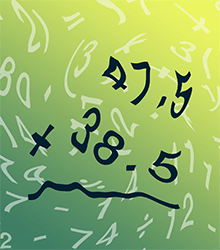Dyscalculia
Dyscalculia is a complex learning disability that affects an individual's ability to
understand and perform mathematical operations. Superficially, it is appear to be
similar to dyslexia, but specifically impacts math skills. It can range in
severity, with some learners struggling with basic math concepts and others having
difficulty with more complex calculations. Dyscalculia affects 5-7% of the population.
Symptoms of dyscalculia may include difficulty with:
- Counting and understanding numbers
- Understanding and using mathematical symbols and operations (such as +, -, ×, ÷)
- Estimating and measuring quantities
- Grasping math concepts, such as place value and fractions
- Solving math problems, even when given step-by-step instructions
- Understanding and using mathematical language in everyday situations
How Grokkoli can help
- Breaks questions down into bite-sized steps
- Recasts questions in a wide variety of visual formats
- Automatically pinpoints the source of a learner’s difficulties
- Provides multisensory instruction
- Practices basic cognitive skills as needed
- Presents 1 question at a time in a simple, clutter-free UI that won't overwhelm learners
Dyslexia
Dyslexia is a neurological condition that affects an individual's ability to read,
write, and spell. It is a common learning disability that affects about 10%
of the population. When it comes to learning math, kids with dyslexia may have
trouble reading math-question, particularly word-problems.
Symptoms of dyslexia may include difficulty with:
- Recognizing and decoding words
- Comprehending what they read
- Spelling and writing
How Grokkoli can help
- Provides multisensory instruction
- Recasts questions in a wide variety of visual formats
- Presents 1 question at a time in a simple, clutter-free UI that won't overwhelm learners
ADHD
Attention deficit hyperactivity disorder (ADHD) is a neurological condition that
affects a person's ability to focus, control impulses, and regulate behavior. It is
a common disorder that affects both children and adults.
Symptoms of ADHD may include difficulty with:
- Paying attention
- Staying organized
- Completing tasks
How Grokkoli can help
- Provides multisensory instruction
- Recasts questions in a wide variety of visual formats
- Prompts learners to take frequent breaks
- Presents 1 question at a time in a simple, clutter-free UI that won't overwhelm learners
Level-2 Autism
Level-2 autism is a complex neurological condition that falls within the broader autism
spectrum. Children with level-2 autism often find social interactions challenging and
overwhelming, may prefer engaging in repetitive behaviors they can perform on their own,
and typically require additional support to help them achieve academically.
Children with Level-2 Autism may experience difficulty with:
- Certain specific aspects of symbolic/abstract math (which may be concentrated on certain specific concepts, such as place-value in number-sense, and vary substantially from one child to another)
- Forming connections across different math-concepts that others might assume to be self-evident
- Maintaining focus if not interested in something
* It's worth noting that children with level-2 autism that develop an intense interest in math will often excel at it and significantly outperform their peers.
How Grokkoli can help
- Recasts questions in a wide variety of visual formats, providing concrete anchors for the abstract symbols & concepts being presented
- When Grokkoli breaks questions, problems, and concepts down into their sub-components, it preserves as much contextual information as possible (the specific numbers involved, the type of
shapes being shown, their colors, etc) to create as much concrete continuity as possible
- Presents 1 question at a time in a simple, clutter-free UI that won't overwhelm learners
Math Anxiety
Math anxiety is an emotional response characterized by feelings of fear, tension, and apprehension when confronted with mathematical tasks or concepts. It can significantly hinder a person's ability to
engage with and perform well in mathematical activities, even if they possess the necessary skills.
Symptoms of Math Anxiety may include:
- Nervousness or unease during math-related tasks
- Fear of making mistakes or being judged for mathematical abilities
- Avoidance of math-related activities or discussions
- Negative self-talk and self-doubt in mathematical situations
- Physical symptoms, such as sweating or an increased heart rate when tackling math problems
How Grokkoli can help
- Math anxiety is not limited to any particular skill level and can impact learners of all ages. Our system is designed to be
supportive and encouraging to help alleviate math anxiety.
- By breaking questions down into bite-sized steps, and recasting questions in a
wide variety of visual formats (where symbolic math bay be a stressor), our system helps build back confidence, reduce anxiety, and foster a
positive attitude towards math
- Presents 1 question at a time in a simple, clutter-free UI to avoid overwhelming learners
Cognitive Impairment
Cognitive impairment is a broad term encompassing various conditions that affect cognitive functions, including memory, attention, problem-solving, and overall intellectual abilities. Individuals
with cognitive impairment may face challenges in processing information and learning new concepts, making mathematics a particularly demanding subject. It can range from mild to severe.
Symptoms of Cognitive Impairment may include difficulty with:
- Retaining and recalling information
- Concentrating on complex tasks
- Grasping abstract mathematical concepts
- Applying problem-solving strategies
- Adapting to changes in mathematical procedures
- Organizing and sequencing steps in mathematical processes
How Grokkoli can help
- Cognitive impairment can manifest in various forms and degrees, impacting each individual uniquely. As our math tutoring system is designed to
adapt to different learning styles and paces, it can provide valuable support to learners with cognitive impairment by offering personalized assistance tailored
to their specific needs.
- Breaks questions down into bite-sized steps
- Recasts questions in a wide variety of visual formats
- Automatically pinpoints the source of a learner's difficulties
- Provides multisensory instruction
- Practices basic cognitive skills as needed
- Presents 1 question at a time in a simple, clutter-free UI that won't overwhelm learners



